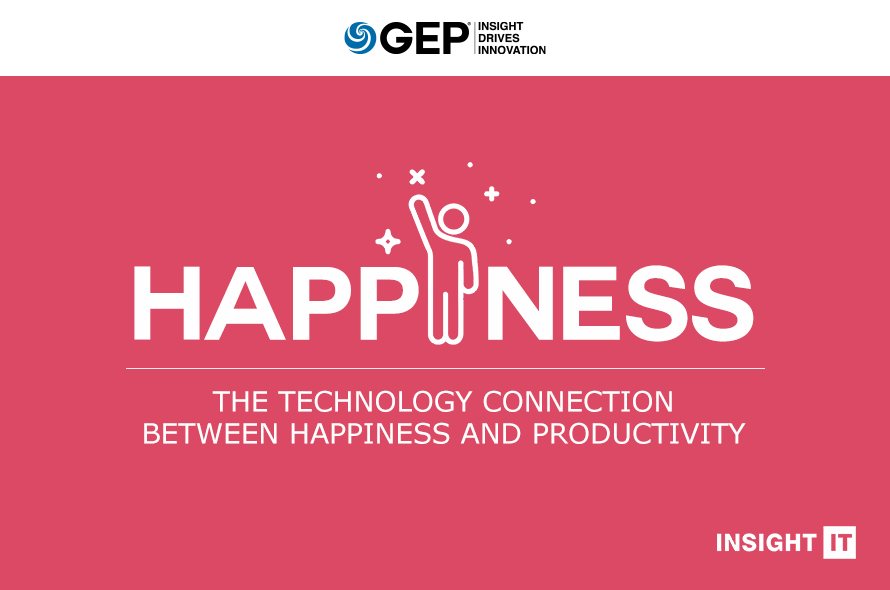What do happy users and good software have in common? The short answer – they both lead to higher adoption and greater workplace productivity.
And although user happiness and productivity go hand in hand, only the right technology can trigger both.
Our new Insight IT piece, “The Technology Connection Between Happiness and Productivity,” explores how user experience (UX) determines the adoption and effectiveness of enterprise applications. It also provides tips on identifying software that provides the best UX for your users.
It’s a must-read for CIOs and IT leaders looking to choose the right software for maximum business impact.
Productivity is a huge factor that makes or breaks businesses, and there is ample evidence that productivity levels are directly affected by the experiences of workplace technology users. Today, the world's best companies are placing a strong priority on more user-friendly enterprise software, not just to get a mere return on investment but to actually drive greater productivity.
As discussed in our earlier Insight/IT piece, “Digital Workplace: How Technology Innovation Can Drive a Return to Productivity Growth,” productivity today is very much connected to technology user acceptance. And the best measure of user acceptance is user satisfaction; essentially, a user's “happiness” with the overall experience of working with a software system.
 Choosing Software That's Loved
Choosing Software That's Loved
The wrong software can become a significant drain on the business due to poor user adoption. You can't force user adoption, and trying to impose it almost always triggers costly disruption. But understanding why users reject certain software can be an important eye-opener. And more often than not, it boils down to one thing — bad user experience (UX).
 It is not enough for users to just accept and use software, a kind of grin-and-bear-it approach. People must want to use the tools they are given, and by doing so, expect to achieve more. Therefore, software that, through engagement and design, makes people more productive delivers the ROI multiples that the software's functionality alone cannot.
It is not enough for users to just accept and use software, a kind of grin-and-bear-it approach. People must want to use the tools they are given, and by doing so, expect to achieve more. Therefore, software that, through engagement and design, makes people more productive delivers the ROI multiples that the software's functionality alone cannot.
Software should also be aligned to how people collaborate and interact in the real world. There are psychological benefits to working in a non-obstructive, integrated environment that encompasses people, processes and the technology tools they use in a harmonious fashion. The stimulation and enjoyment (or inverse reactions) that users experience when interacting with technology are just as vital in earning their confidence as coworkers.
What UX Is Not
It's worth noting that an overabundance of features and functions does not equal good user experience. Business software is typically feature-heavy, labor- intensive and complex — and therefore hard to use. But that statement itself contains a logical flaw; modern developments in UX and software design are disproving this. Feature-rich, complex, powerful software need not be hard to learn, onerous to use or cumbersome.
 Lessons From the Internet Giants
Lessons From the Internet Giants
We can look to some of the world's leading companies for evidence that complex software can be made easier to use, and can help achieve desired outcomes faster.

The success of businesses like Facebook and Amazon is largely down to their consistent practice of determining how people do things, and then tailoring their platforms to both align to user behavior and to steer it. Their users can do more, so they do do more, and the companies profit accordingly.
In the workplace, most employees would like the ability to be more productive. However, most enterprise software doesn't give them the ease and flexibility to do more than they already are.
The realization that business software should incorporate “consumerized” UX is a very recent phenomenon.
 Application in Procurement & Supply Chain
Application in Procurement & Supply Chain
The procurement function, from a user's perspective, should be much more productive. Procurement and supply chain professionals should not have to invest time in becoming experts with unnecessarily complex software; their forte lies in the value they can bring to the enterprise. The tool must therefore allow them to simplify their work processes and provide an environment favorable to collaboration across the enterprise.
Purchasing should be even easier. Users should be able to simply state what they want and let the software guide them to where they can get it. A purchasing system should automatically select the best product at the best price from the best supplier as dictated by approved contracts, and simply notify the user when a purchase has been made. The end user, whose only requirement is the item they need, should not have to be involved in any other process.
Not every procurement platform is designed to represent this viewpoint. In contrast, procurement software such as GEP SMART eliminates routine and redundant processes, speeds up complex tasks, and intelligently provides tools, information and resources to help people achieve more, get better results and succeed in their work. This ease is achieved through rigorous attention to user experience. By marrying complex functionality to simplified human interaction, GEP SMART defines positive UX.
 Software Selection — A Team Effort
Software Selection — A Team Effort
Acknowledging the positive impacts of well-designed business software on productivity is a good first step. But how do you go about selecting or developing an enterprise software system that offers your users the right UX?
- For starters, always keep your users in the loop when making decisions that directly involve them. This way, you can avoid committing IT spend in a vacuum without knowing how the intended users might react to your choice of software.
- Partner with your users as well as your process-owner stakeholders in decision- making, understand the challenges they
face, and seek their inputs or suggestions. After all, they are the ones who will be most affected by the decision. Having open lines of communication can serve you well later when you're trying to measure outcomes. - Take the time to find out what will actually make your user community happy — learn about what they need and want from their software.
Workers are often advised to focus on being productive, as opposed to just “busy.” Software with poor UX will keep users busy, but they won't be happy and certainly won't be as productive as they would like to be, or need to be. The best results will come from a diligent effort to gather information about how specific groups work, and then match this insight to a software product that is designed for the purpose with the right UX in its DNA.

